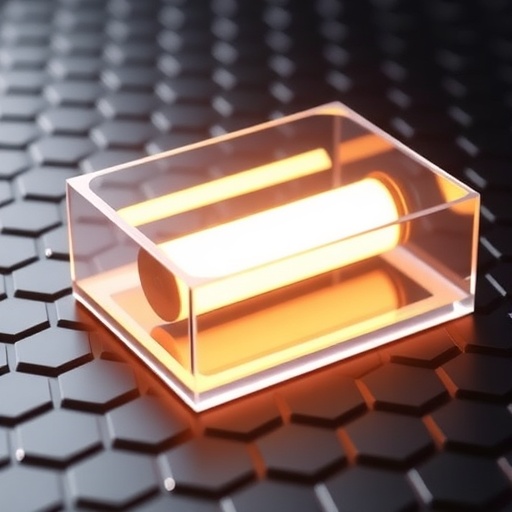Physicists Unveil Definitive Evidence of Unconventional Superconductivity in Magic-Angle Twisted Tri-Layer Graphene
Superconductors have long been hailed as the future of energy-efficient technology, allowing electric current to pass through them with zero resistance, akin to express trains running non-stop through a subway system. Their capacity to conduct electricity without energy loss makes them indispensable in applications ranging from medical imaging to particle acceleration. However, the vast majority of known superconductors demand cooling to near absolute zero, constraining their practicality for widespread technological innovation. Unlocking superconductivity at ambient temperatures remains one of the most formidable challenges in physics, promising revolutionary advances in power transmission and quantum computing.
In pursuit of this goal, researchers have turned their attention to a captivating class of materials known as “unconventional superconductors,” which depart fundamentally from the mechanisms underlying traditional superconductivity. Among these, a particularly intriguing system has emerged: magic-angle twisted tri-layer graphene (MATTG). Crafted by stacking three atomically thin graphene sheets with an exacting rotational alignment, MATTG hosts a variety of exotic quantum phases that have captivated theorists and experimentalists alike. Until now, empirical evidence linking MATTG to unconventional superconductivity remained elusive and indirect.
Today, a collaborative team of physicists at MIT has reported groundbreaking experimental observations conclusively demonstrating that MATTG harbors an unconventional superconducting gap — the energy range that characterizes how robustly electrons pair within the superconducting state. This achievement, detailed in the prestigious journal Science, represents a watershed moment in the field by furnishing the most direct proof to date that superconductivity in MATTG arises from an exotic, previously unclassified mechanism distinct from that in conventional superconductors.
Superconductivity is fundamentally rooted in the formation of Cooper pairs — bound electron pairs that move through a lattice without scattering. Unlike conventional superconductors, where these pairs are loosely coupled over long distances via lattice vibrations, MATTG exhibits signatures indicative of tightly bound pairs forming through strong electronic correlations. The MIT team employed a novel experimental methodology combining tunneling spectroscopy with electrical transport measurements, enabling them to simultaneously detect the superconducting gap and the zero-resistance hallmark of superconductivity in the same sample.
This experimental platform revolves around the phenomenon of quantum tunneling, whereby electrons behave as waves capable of penetrating barriers that would be impenetrable according to classical physics. By “tunneling” electrons between graphene layers twisted at the magic angle—approximately 1.56 degrees—the researchers could probe the precise structure of the superconducting gap as a function of temperature and magnetic field. Remarkably, the superconducting gap in MATTG displayed a distinctive V-shaped profile, unequivocally differentiating it from the flat, uniform gap characteristic of classical superconductors. This nodal gap structure implies that the pairing mechanism is not mediated by conventional phonon interactions but rather emerges from complex electron-electron interactions intrinsic to the material’s moiré superlattice.
The implications of this discovery are profound. Unraveling the mysterious pairing glue in MATTG paves the way for engineering new superconductors that function at higher temperatures, potentially even reaching room temperature — the “Holy Grail” for quantum materials research. Such materials would transform energy systems by eliminating resistive losses and enhancing the scalability of quantum devices. According to co-lead author Shuwen Sun, these insights into the superconducting gap provide critical clues that could steer the rational design of next-generation superconductors.
Graphene, a single monolayer of carbon atoms arranged in a hexagonal lattice, earned widespread acclaim for its remarkable mechanical and electronic properties. Early theoretical work foresaw that twisting two graphene sheets at a magic angle could lead to flat electronic bands with strongly correlated electrons, triggering unconventional phases including superconductivity and insulating states. The MIT group, led by Professor Pablo Jarillo-Herrero, pioneered these experiments in 2018, unveiling the extraordinary physics of magic-angle bilayer graphene and subsequently expanding their explorations to tri-layer and multilayer systems. Their continued investigations have consistently revealed phenomena defying conventional theory, cementing twisted graphene’s status as a versatile platform for probing exotic quantum matter.
In the context of the latest study, the integration of tunneling spectroscopy with transport measurements represents a powerful innovation. Historically, tunneling approaches could suggest the presence of a superconducting gap but fell short of conclusively tying these spectroscopic features to true superconductivity due to the absence of simultaneous resistivity data. By innovatively merging these techniques, the MIT team ensured that measured spectroscopic signatures were directly correlated with the superconducting state, providing a high-fidelity window into the dynamics of electron pairing as superconductivity develops.
The observed nodal superconducting gap — characterized by points or lines where the gap energy goes to zero — is emblematic of an unconventional superconducting order parameter with complex symmetry. Such states are fertile ground for emergent phenomena like topologically protected excitations and could enable fault-tolerant quantum computing architectures. The tightly bound electron pairs suggested by the data imply that pairing arises from electronic interactions rather than lattice vibrations, challenging long-standing paradigms and motivating fresh theoretical perspectives.
Looking ahead, the researchers plan to harness their sophisticated platform to parse the superconducting and correlated phases across a wider array of two-dimensional, twisted van der Waals networks. This capability promises to systematically chart the phase diagrams of myriad quantum materials, revealing hidden relationships between crystal symmetry, electron interactions, and emergent superconductivity. As articulated by Professor Jarillo-Herrero, a deep understanding of unconventional superconductors like MATTG will catalyze the design principles necessary for crafting electronic materials that meet society’s pressing technological demands.
This work was possible thanks to generous funding from diverse agencies, including the U.S. Army Research Office, the U.S. Air Force Office of Scientific Research, MIT’s Samsung Semiconductor Research Fund, and several private foundations, underscoring the broad strategic importance attributed to quantum materials research in national and international scientific agendas.
Subject of Research: Unconventional superconductivity in magic-angle twisted tri-layer graphene
Article Title: Experimental evidence for nodal superconducting gap in moiré graphene
News Publication Date: 6-Nov-2025
Web References: DOI: 10.1126/science.adv8376
Image Credits: Pablo Jarillo-Herrero, et al
Keywords
Superconductors; Semiconductors; Electrical conductors; Electrical engineering; Engineering; Superconduction; Superconductivity; Graphene; Physics




